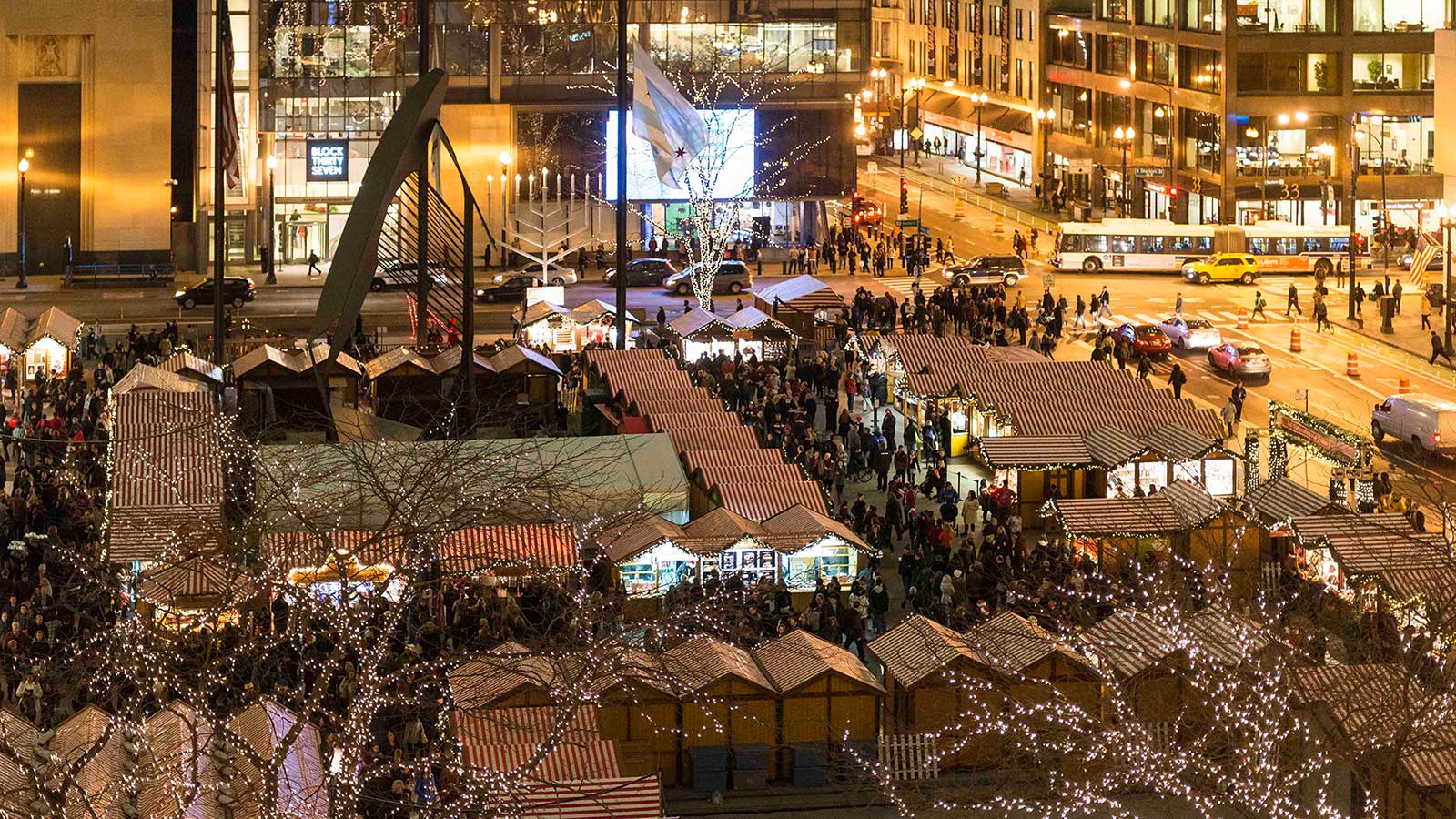Why Chicago’s Christkindlmarket Is The Future Of Office & Retail
The future of in-person real estate, particularly in the office and retail sectors, hinges on prioritizing walkability and experiences. As remote work and e-commerce continue reshaping how people engage with physical spaces, developers, landlords, and tenants must reimagine how to attract and retain visitors. Spaces need to be more than functional—they must offer immersive and convenient environments that foster connection, engagement, and a sense of community. A perfect example of this dynamic in action is Chicago’s Christkindlmarket, where an emphasis on experiential design created a massive draw despite overcrowding challenges.

Walkability: A Cornerstone of Urban Success
Walkability is critical in creating vibrant urban environments, and it is increasingly at the forefront of successful real estate projects. Easy access to restaurants, shops, public transit, and cultural activities has become a primary driver of demand for office and retail spaces. Studies show that people are willing to pay a premium for properties in walkable neighborhoods, where they can seamlessly integrate work, shopping, and leisure into their daily lives.
Office Sector and Walkability
As hybrid work models continue to dominate, the office sector must embrace walkability as a way to stay relevant. Many employees now choose where to work based on proximity to dining, fitness centers, entertainment, and public spaces. An office building surrounded by a lively, walkable environment can attract tenants better than one in a remote or inaccessible location. Developers are responding by creating mixed-use office developments, where workplaces are part of a larger, walkable community that includes retail, hospitality, and residential components.
Retail Sector and Walkability
Retail, too, thrives in walkable areas. With consumers demanding more than just transactional experiences, retail spaces in walkable neighborhoods are evolving into social hubs, offering more reasons to linger. Brick-and-mortar stores are transforming into spaces where people can meet friends, grab coffee, or attend events. These stores rely on being situated within walking distance of other attractions to sustain foot traffic.
Experiences: The Future of Physical Real Estate
Experiences have become the linchpin for in-person real estate. A walkable environment is only part of the equation; people are increasingly drawn to spaces that offer more than utility. Creating experiential destinations transforms real estate from a necessity into a choice.
Office Experiences
Modern office environments are moving beyond cubicles and conference rooms. Tenants demand collaborative spaces, wellness centers, and vibrant communal areas that feel less like workplaces and more like lifestyle hubs. Experiences such as pop-up events, yoga classes, and food trucks are increasingly popular, helping offices compete with the allure of remote work. These activities encourage employees to return to the office for networking, collaboration, and recreation, not just for their jobs.
Retail Experiences
The retail sector has seen a dramatic shift toward experience-driven spaces. Rather than competing with e-commerce, physical stores are thriving by offering what online shopping cannot: personal connection and multisensory experiences. Examples include interactive product demonstrations, live performances, and pop-up markets that create emotional consumer engagement. Retail spaces integrating dining, entertainment, and cultural activities are particularly successful in fostering community and driving consistent traffic.
The Christkindlmarket as a Case Study
Chicago’s Christkindlmarket is a shining example of how walkability and experiences create a powerful draw for physical spaces. Located in the heart of downtown, the Christkindlmarket brings people together for unique shopping, dining, and cultural experiences. Its walkable location makes it accessible for tourists, suburban visitors, and city residents alike. While recent reports highlight the overcrowding issues, they also underscore its immense popularity and the public’s appetite for such immersive experiences.
Key Elements of the Christkindlmarket’s Success
- Unique Experiences: The market offers a one-of-a-kind experience, combining festive décor, authentic German food, and handcrafted gifts. Visitors aren’t just shopping—they’re creating memories and engaging with cultural traditions.
- Walkable Location: Situated in Daley Plaza, the market benefits from its proximity to offices, hotels, and public transit, making it an easily accessible destination.
- Community and Festivity: The market provides an atmosphere that fosters social connection, with visitors coming together to enjoy hot mulled wine, live music, and holiday cheer.
- Event-Driven Traffic: The Christkindlmarket leverages its seasonal appeal to create urgency and excitement, turning it into a must-visit attraction during the holidays.

Lessons for Office and Retail Real Estate
The Christkindlmarket’s popularity highlights how walkable, experience-driven spaces can thrive in the modern real estate landscape. Office and retail developments can emulate its success by:
- Creating cultural and seasonal events to draw consistent traffic.
- Prioritizing public spaces and accessibility to enhance the walkability of their locations.
- Blending commerce with social and recreational opportunities, making them destinations rather than just places to work or shop.
Challenges and Opportunities
While walkability and experiences are key to the future of in-person real estate, implementing them comes with challenges. Overcrowding at the Christkindlmarket demonstrates how even highly successful events can suffer from logistical issues. For real estate developments, balancing accessibility and capacity is crucial to avoid negative experiences.
Challenges
- Urban Congestion: Increasing density in walkable areas can strain public infrastructure, creating traffic and overcrowding.
- Costs of Innovation: Designing experiential spaces often requires significant upfront investment, from amenities to programming.
- Changing Consumer Expectations: Tenant and consumer preferences are constantly evolving, requiring developers to stay ahead of trends.
Opportunities
- Revitalizing Underperforming Properties: Walkability and experiential programming can breathe new life into outdated office and retail properties.
- Blending Uses: Mixed-use developments that combine offices, retail, and entertainment in a walkable environment create destinations that appeal to a wide range of users.
- Leveraging Technology: Digital tools, such as apps for wayfinding and event management, can help enhance the experiential aspects of physical spaces.

